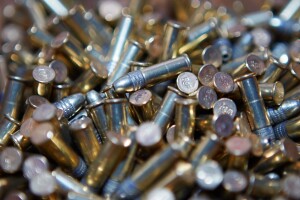 It is unfortunately common to hear the mass media exclaim in disgust about how much ammo someone had. Usually this is after some horrific crime where the talking heads on the television need the viewer to understand how evil the perpetrator was. They would have you believe that anyone who has 5,000 rounds of ammo can’t be normal, and what better way to make someone appear to be a member of the lunatic fringe than to make obvious the depths to which they would sink in the name of preparedness? Take this quote from the LA Times in response to the December 2015 San Bernardino massacre:
It is unfortunately common to hear the mass media exclaim in disgust about how much ammo someone had. Usually this is after some horrific crime where the talking heads on the television need the viewer to understand how evil the perpetrator was. They would have you believe that anyone who has 5,000 rounds of ammo can’t be normal, and what better way to make someone appear to be a member of the lunatic fringe than to make obvious the depths to which they would sink in the name of preparedness? Take this quote from the LA Times in response to the December 2015 San Bernardino massacre:
Farook and Malik fired up to 75 rounds during their killfest and 76 while exchanging fire with police. Cops found 4,500 rounds at their home and 1,600 in their car.
Nobody needs that many bullets unless they’re arming for mass mayhem.
The message is simple: normal people don’t have that much ammo. But how much is too much? Well, that seems to be up to the people judging the alleged criminal in the name of news. Certainly 5,000 seems like a lot. But is it, really? The answer is, as is often the case, not so simple.
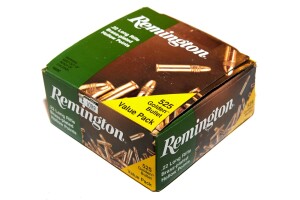 Let’s take a look at some of the most common ammunition: the 22 caliber long rifle, or .22LR, a box of which is shown to the right. You can see that there are 525 rounds in this box. You can also see that the price on this box is $10.99, which proves nothing other than I’ve had the box for a very long time. A box like this is often called a “brick” of .22 by firearms enthusiasts, and back in the day we’d buy such a brick of .22 and head to the range for some fun. These days with the prices the way they are, we tend to buy bricks in bulk.
Let’s take a look at some of the most common ammunition: the 22 caliber long rifle, or .22LR, a box of which is shown to the right. You can see that there are 525 rounds in this box. You can also see that the price on this box is $10.99, which proves nothing other than I’ve had the box for a very long time. A box like this is often called a “brick” of .22 by firearms enthusiasts, and back in the day we’d buy such a brick of .22 and head to the range for some fun. These days with the prices the way they are, we tend to buy bricks in bulk.
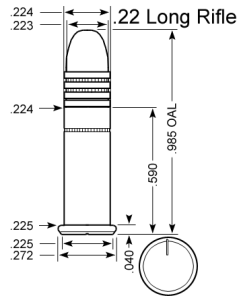 If you’re not familiar with firearms, you might think that this is a large case of ammo, but that is quite inaccurate. The .22LR bullet is 0.223″ in diameter (which is where the .22 comes from), and the overall length of the cartridge (the bullet, casing, powder and primer as a single unit) is less than an inch (.985″) long. As a result, that box of 525 rounds measures about five inches square.
If you’re not familiar with firearms, you might think that this is a large case of ammo, but that is quite inaccurate. The .22LR bullet is 0.223″ in diameter (which is where the .22 comes from), and the overall length of the cartridge (the bullet, casing, powder and primer as a single unit) is less than an inch (.985″) long. As a result, that box of 525 rounds measures about five inches square.
Remember, this is one of the most common types of ammunition in the US today! They are generally sold in boxes of 50 or 100, and often come in boxes like the one shown which usually have either a loose collection of hundreds of cartridges or many smaller boxes packed within it.
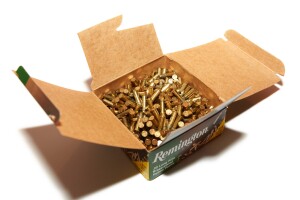 The point is that this is not a physically large box, but the ammo is small, so it contains a lot of it. But that’s not all that’s germane to this discussion.
The point is that this is not a physically large box, but the ammo is small, so it contains a lot of it. But that’s not all that’s germane to this discussion.
Ammo is expensive. This box with it’s $10.99 price tag is from a purchase I made in 2005. It’s 10 years old as of this writing, but that’s OK because ammo doesn’t really go bad if its well cared for. In fact, there can be significant cost savings made if ammo is purchased in bulk when the price is low.
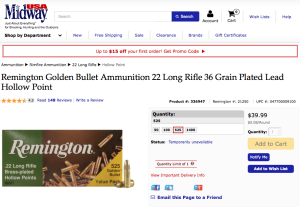 How much is that same box of ammo selling for today? Here’s a screen-capture of a page from Midway.com, a well-known shooting supply source, taken on December 6, 2015 where the same box of ammo is $39.99. I quadrupled my investment in just 10 years. Not too shabby.
How much is that same box of ammo selling for today? Here’s a screen-capture of a page from Midway.com, a well-known shooting supply source, taken on December 6, 2015 where the same box of ammo is $39.99. I quadrupled my investment in just 10 years. Not too shabby.
Seriously, though, ammo is expensive, and as anyone with any experience will tell you, it’s almost always better to buy when there’s a sale. It’s also generally cheaper to buy in bulk. On that same page you can see that there’s an option for buying a container of 1400 rounds of the same ammo, That single purchase would make you guilty of “arming for mass mayhem” according to the LA Times.
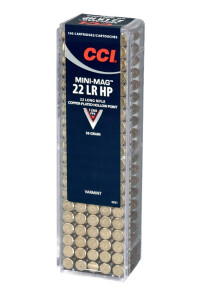 Let’s look at a different example. CCI makes one one of the most popular brands of 22LR ammo available today. It is commonly sold in 100-round boxes that hold each round in place. They’re fabulous boxes (which are also sometimes called bricks) of absolutely stellar ammo named “Mini Mag” by CCI. Do any reading on .22 caliber guns and you’ll see this ammo almost universally recommended.
Let’s look at a different example. CCI makes one one of the most popular brands of 22LR ammo available today. It is commonly sold in 100-round boxes that hold each round in place. They’re fabulous boxes (which are also sometimes called bricks) of absolutely stellar ammo named “Mini Mag” by CCI. Do any reading on .22 caliber guns and you’ll see this ammo almost universally recommended.
As a frame of reference, if I’m going to the range with my .22, I’d likely grab four of these boxes. That’s 400 rounds of .22LR for one range trip. I might not use them all, but I have a revolver that holds 10 rounds and a rifle that holds 10 rounds, and when you’re out plinking with friends, it’s very easy to go through a couple hundred rounds of .22 in an hour’s worth of time. That’s an hour of fun, by the way, not an hour of mass mayhem.
 The problem with 100-round boxes of .22 is that they’re usually more expensive than the larger boxes, but the 100-round boxes are so convenient that many shooters prefer them. So what do we do? We buy them by the case. There are 50 boxes of Mini-Mags in a case, and thanks to some basic math, that’s 5,000 rounds: 5,000 rounds of ammo in one box that’s about 12″ by 18″ in size.
The problem with 100-round boxes of .22 is that they’re usually more expensive than the larger boxes, but the 100-round boxes are so convenient that many shooters prefer them. So what do we do? We buy them by the case. There are 50 boxes of Mini-Mags in a case, and thanks to some basic math, that’s 5,000 rounds: 5,000 rounds of ammo in one box that’s about 12″ by 18″ in size.
But enough about .22s, what about other ammo? Let’s take a look at shotgun shells.
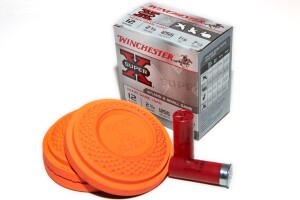 To shoot a round of trap requires 25 shotgun shells, which is why they often come packaged 25 to a box. And just like most things, they’re cheaper when you buy them in bulk. If I go to practice my trapshooting skills at the range, I might shoot five rounds which equates to 125 rounds in one day. Note that five rounds of trap is also a half-case of ammo, so it makes sense to buy it by the case which is usually 10 boxes of 25 for a total of 250 rounds.
To shoot a round of trap requires 25 shotgun shells, which is why they often come packaged 25 to a box. And just like most things, they’re cheaper when you buy them in bulk. If I go to practice my trapshooting skills at the range, I might shoot five rounds which equates to 125 rounds in one day. Note that five rounds of trap is also a half-case of ammo, so it makes sense to buy it by the case which is usually 10 boxes of 25 for a total of 250 rounds.
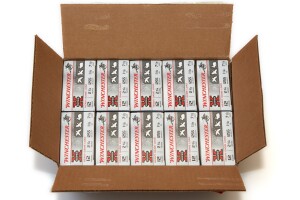 But who actually needs that much ammo? Anyone who shoots regularly. The simple truth is that ammunition is a consumable aspect of the shooting sports. Just as driving consumes gasoline, shooting consumes ammunition. What most people outside of the shooting sports seem to miss is how quickly ammo gets consumed while practicing, plinking, or other recreational (or competitive) pursuits like trap, skeet, or sporting clays.
But who actually needs that much ammo? Anyone who shoots regularly. The simple truth is that ammunition is a consumable aspect of the shooting sports. Just as driving consumes gasoline, shooting consumes ammunition. What most people outside of the shooting sports seem to miss is how quickly ammo gets consumed while practicing, plinking, or other recreational (or competitive) pursuits like trap, skeet, or sporting clays.
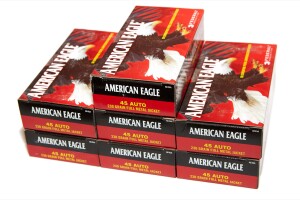 That raises another point. Anyone who competes in anything knows that practice is the only way to improve and hone skills. A typical handgun competition might average 125-150 rounds. Some might require 250 rounds, but again, that’s for the competition itself. If you’re practicing 10 times before the competition, that’s an easy 2,500 rounds, and if you compete in, say, handgun competitions as well as trap, then you’re into 5,000 rounds because you have multiple calibers. And that’s just for practice.
That raises another point. Anyone who competes in anything knows that practice is the only way to improve and hone skills. A typical handgun competition might average 125-150 rounds. Some might require 250 rounds, but again, that’s for the competition itself. If you’re practicing 10 times before the competition, that’s an easy 2,500 rounds, and if you compete in, say, handgun competitions as well as trap, then you’re into 5,000 rounds because you have multiple calibers. And that’s just for practice.
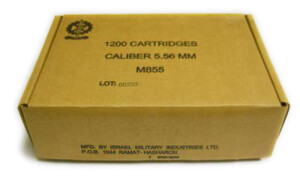 Remember those containers of 1400 .22LR I wrote about? Rifle ammo sometimes comes in 30-round boxes packed into 1,400 round cases, too. These cases can be a real bargain when the price is right, not to mention that their value goes through the roof any time there’s talk of gun control which leads people to buy more than one case at a time so that they have it when the prices get ridiculous. Back in 2001 I used to buy similar ammo for less than $300 a case. In 2014 I saw it selling for almost $1,000. If you knew you needed, say, batteries, and you knew that the price was going to triple, wouldn’t you buy a case of batteries while the price was low? It’s the same principle.
Remember those containers of 1400 .22LR I wrote about? Rifle ammo sometimes comes in 30-round boxes packed into 1,400 round cases, too. These cases can be a real bargain when the price is right, not to mention that their value goes through the roof any time there’s talk of gun control which leads people to buy more than one case at a time so that they have it when the prices get ridiculous. Back in 2001 I used to buy similar ammo for less than $300 a case. In 2014 I saw it selling for almost $1,000. If you knew you needed, say, batteries, and you knew that the price was going to triple, wouldn’t you buy a case of batteries while the price was low? It’s the same principle.
Another Facet
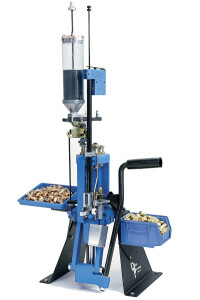 As I’ve written already, if you want to stay proficient with a firearm (as every gun owner should), then you’ll need to spend money on ammo. Ammunition is so expensive that people who compete or just love shooting can easily spend thousands upon thousands of dollars on it.
As I’ve written already, if you want to stay proficient with a firearm (as every gun owner should), then you’ll need to spend money on ammo. Ammunition is so expensive that people who compete or just love shooting can easily spend thousands upon thousands of dollars on it.
What many people outside of the shooting sports don’t know is that ammo can be made at home. It’s a bit complicated to learn, it’s time-consuming, and it requires excellent attention to detail, so it’s not something that every gun-owner does, but there are plenty of people out there who are hand-loading their own ammo.
Not only that, but the brass shell-casing from most ammo can be reused. This is called reloading, and since brass is so expensive, this can result in a significant cost savings for a gun owner who may need thousands of rounds of ammo over the course of a year. It is not uncommon for a hand-loader or reloader to make 1,000 rounds at a time because sitting in front of the machine requires time, patience, and attention.
Isn’t all that ammo a fire hazard?
Not as much as you’d think. Check out this video from SAMMI where they literally take a house full of ammo and burn it to the ground to see how it would impact the safety of firefighters.
Sadly most reporters have never seen this video, so they don’t know that ammo isn’t the danger they assume it to be. As an example, this report which was on the front page of the NJ Daily Record had the stunning headline that bullets were flying during the fire where ammo was stored in a detached garage. It then goes on to say, “Firefighters could hear ammunition firing from inside the garage, Cleary said, but said no bullets or fragmentation from any of the rounds were found outside the garage.”
Yes, cartridges can ignite in a fire, but what makes a bullet dangerous isn’t the ignition, but rather the forced escape of the bullet through an enclosed space: a gun barrel. Beware of sensational headlines that aim to mislead in order to sell papers, ad space, or a narrative.
But what about those guys with 10,000 rounds of ammo? That’s insane, right?
No, not really.
Let’s say there’s a great sale and I’ve got some extra cash, so I buy a case of .45ACP ammo. Now I’ve got 250 rounds of that caliber. People who are into shooting generally have more than one firearm, and they’re generally of different types and calibers. A typical breakdown might be:
| Firearm | Caliber | Intended Use | Notes |
|---|---|---|---|
| Shotgun | 12 gauge | Trap | |
| Rifle | .308 | Hunting | |
| Rifle | .223 | Target | |
| Rifle | .22LR | Plinker | |
| Revolver | .357/.38Spl | Competition | Two calibers |
| Pistol | .45ACP | Competition |
Six guns, all of which can serve very different purposes, and all of which need different types of ammo. .22LR is easy to stock up on, so I buy a case of 5,000 rounds. Next, I buy a case of .45ACP (250), a case of .357 (250), a case of .38 special (250), and a case of 12-gauge (250). Suddenly I’ve got 6,000 rounds. If the sale is really good and prices are low, I might buy two cases of each center-fire caliber, and now I’ve got 7,000 rounds.
Remember that ammunition prices have skyrocketed in the past few years, so if I came across a deal on those 5,000-round cases of .22LR, you can bet I’d buy more than one! Well, two cases is 10,000 rounds.
Really, though, what matters is how often I get to shoot. Going to the range is fun! Bringing some friends is even more fun, but when I do that, especially if they’re not gun-owners, then I’m using even more ammo. I once brought three friends to the range where we went through 1,000 rounds of various types of ammo in the span of about three hours. It’s very easy to do.
Conclusion
The fact that someone has 5,000 rounds of ammunition in their possession is not by itself an indication of malice, but it sounds scary to people who are unfamiliar with firearms and if there’s one thing the news loves to do, it’s scare people.
Try to remember that when someone on the news talks about the vast amount of ammo found at someone’s home that they are trying to manipulate you into believing a narrative. And by the way, every time that happens people stock up on more ammo because the argument to tax, limit, or outright ban ammunition is rekindled which raises the prices all over again, and the only way to avoid paying those high prices is to have bought in bulk while the prices were low.
Being prudent does not make someone a terrorist.